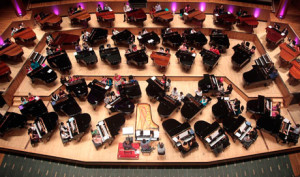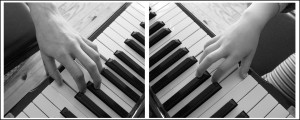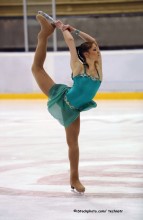
Pianists seem to be used as research subjects more often than any other musicians – perhaps because there are so many of us, both amateur and professional. I once met a well-known singer who, upon finding out that I was a pianist, remarked that pianists “are a dime a dozen.” Not the most gracious comment when meeting someone. On the other hand, our numbers guarantee a ready supply of subjects for neuroscience research, including research on mirror neurons. And speaking of lots of pianists, I couldn’t resist this photo of fifty-two pianos with, I believe, two pianists at each piano, taken at Royal Festival Hall in London in May 2011 on a “massed piano day,” held during a five-day mini festival, “Lang Lang Inspires.” This photo illustrates an aspect of mirror neurons that I hope will become clear over the next few posts.
Some of the critics of mirror neuron research say that these neurons have been overhyped – that they can’t possibly be responsible for everything that has been attributed to them, and that may be true. But it’s definitely not an overstatement to say, based on current studies, that mirror neurons have a huge impact on how we learn a musical instrument, how we teach an instrument, and how an audience not only views the performer but perceives the music itself when we perform. So it’s probably a good idea for musicians to know about these specialized brain cells and how they function.
I have talked about mirror neurons as brain cells that fire both when we perform an action and when we see that same action being performed (in most scientific studies, they refer to this as action observation). But researchers have found that musicians have both a visual (action observation) and an auditory mirror neuron system.
They have discovered that motor areas of the brain are activated when pianists observe piano playing – without sound. (This has been found with guitarists as well.) So imagine that you are watching a musician playing a piece that you know and there is no sound. Neurons in the motor areas of your brain are going to be actively firing even though you are doing nothing.
And researchers have looked at the brains of pianists while they are listening to music that they know well and have found that mirror neurons in motor areas of the brain are being activated. Many of you have had the experience of sitting at a concert listening to music that you play, and find that your fingers are moving as though you yourself are playing. That’s because the mirror neurons in your own motor areas are active. This connection between auditory and motor areas of the brain is called, not surprisingly, the auditory-motor loop and we’ll be talking more about that at another time.
So not only are mirror neurons active when we watch someone playing our instrument, but also when we hear someone playing the instrument. And there is no reason to think that this is not also true of all musicians – not just pianists.
So we know that mirror neurons are imitation neurons. We learn movements, or an action, by seeing it done by someone else. It can be unconscious, as when a small boy unknowingly imitates his father’s walk. Or it can be a more conscious effort, as when we are learning a musical instrument. Learning happens when we transform what we are seeing into a nearly identical motor action that we are doing, and this process relies on the mirror neuron system.
And yes, cognition also plays a role. We need to understand why we are learning something, what we are learning, and what the goal is. But suppose you wanted to learn to play tennis, and had never seen anyone play. If you receive verbal instruction only – telling you how to hold the racket, explaining a serve, describing a backhand, it’s probably going to be difficult to learn to play. On the other hand, watching someone’s backhand or serve facilitates the learning process because of this imitation system in our brains that maps what we see onto our motor system.

Or imagine that you are having a first piano lesson. You are told how to hold your hand over the keys, how the fingers should be curved, what the position of your arm should be, etc., etc., etc. It would take a lot of explanation and still not be very efficient – especially with a young child. But look at the position of your teacher’s hand, and you instantly know how to hold yours, as in the photo above (mother and daughter). I am aware, as I write this, that there are very good blind pianists, and obviously they did not learn by imitation. And I once saw a really bad movie about a competition-winning blind figure skater, but I think that happens only in the movies. Most of us rely on imitation to learn motor skills.
As I wrote in an earlier post, I have been a life-long fan of figure skating. As I was watching  the Olympic skaters a few weeks ago, I was thinking about mirror neurons. My mirror neurons would have been considerably active as I watched movements that were at one time in my skating repertoire – basic forward and backward and maybe a simple spin or two. They would have fired less when I watched more complicated moves such as the one shown at the left because that move is far beyond what my brain and muscles know how to do.
the Olympic skaters a few weeks ago, I was thinking about mirror neurons. My mirror neurons would have been considerably active as I watched movements that were at one time in my skating repertoire – basic forward and backward and maybe a simple spin or two. They would have fired less when I watched more complicated moves such as the one shown at the left because that move is far beyond what my brain and muscles know how to do.
For actions to be mirrored in the brain, your brain must have a template for those actions – a template that is based on your own repertoire of movements. The better you are at an activity, the more active your mirror neurons will be when you observe someone else performing that activity.
If you are a good tennis player, your mirror neurons will be very active when you watch a tennis match. But even for someone like me who doesn’t play tennis, mirror neurons will fire to some extent because the movements a tennis player makes are not dissimilar to everyday actions that I do with my arms and legs – those movements are just being used in a different context. As a pianist, my mirror neurons will be very active when I watch another pianist perform. But the mirror neurons of even a non-musician will fire to some extent because again, as in tennis, arm or body movements that a pianist makes are not dissimilar to everyday movements that a non-musician may make – again in a different context. And this may make us think again about Dr. Tsay’s research discussed in an earlier post.
According to Giacomo Rizzolatti, who discovered mirror neurons, when you observe motor activity that you currently cannot do (such as the complex skating position above) that has some relationship to moves that you can do – you are primed to be able to learn the more complicated maneuver. In other words, because I have a template in my brain for simple skating moves, I will more readily learn complicated moves after watching them.
According to other mirror neuron researchers, we learn a new motor pattern by rearranging elementary motor acts that we already know into a new pattern. So supposing we have learned the most basic patterns of hand position and technique by instruction and by observing a teacher. As we progress to learning more complicated technical patterns, the movements we observe our teacher doing (or see in a video or technique book) are processed in higher order visual areas of the brain and then mapped onto the motor counterpart in the brain – building on the actions we already know how to do. That, of course, doesn’t mean that we can instantly perform the more complicated technical pattern – that’s what practice is for. But mirror neurons provide a template for learning the more complicated pattern.
We know there is a progression in learning and we build on what we know. You aren’t going to be able to learn to do a quadruple axel if you can’t do a triple. You can’t learn a double axel before you can skate backwards. You won’t be able to learn a Beethoven Sonata if you haven’t mastered Clementi Sonatinas or their equivalent, and you won’t be able to play Clementi until you have learned basic five-finger patterns. We usually teach with a logical progression in mind. What hasn’t been clear until the discovery of, and research on, mirror neurons is the crucial importance of observation in learning new actions or techniques.
We should encourage students to attend professional concerts as often as possible – to see performers play music that is beyond the student’s current capabilities but to which he can aspire – and we should always demonstrate. And that puts the burden squarely on the teacher to be certain that we are modeling healthy ways of playing the instrument or practicing the sport, because the student will mirror what we are doing, whether or not it is a healthy approach that is based on sound knowledge of anatomy and how the body works.
There are dozens of books about technique for every instrument; most of these involve photographs of correct finger position, hand position, arm position, embouchure – depending on the instrument. Mirror neurons are activated by looking at photos, so photos are helpful, but not as helpful as seeing the real thing. Mirror neurons are activated more strongly, and learning is facilitated more rapidly, when seeing live action or videos as opposed to still photos. (And of course, we have You Tube, with videos showing us how to do everything.) Several years ago, I was asked by a major university press to review a book on piano technique. It was an excellent book, and I suggested that it would be enhanced if they added a DVD or directed readers to a website with videos demonstrating various technical issues that the author was trying to explain. That never happened, but a video would have had far more impact on the pianists using the book than explanations and the occasional photo.
Mirror neurons aren’t everything when it comes to learning motor skills, but they certainly are significant. Next time I’ll talk about mirroring vs. mimicking and what that means when teaching a musical instrument.
2 responses to “Mirror neurons and music, part III: imitation learning”
So many pianists and so few singers? Then why are they always looking for accompanists? 🙂 But I digress…
Just last week I showed a young student how to balance (the word I use rather than “position”) his hand on the keys. I said, “Take a mental snapshot of this.” Then we both pretended we had shutter buttons on our foreheads with which to “snap” the image. I find it useful to remind students to remember what they are seeing. Thanks again for more info on mirror neurons.
Lots of singers also, but I think researchers like pianists’ “external” instrument. Your mental snapshot idea is a great one. I think we all need to be reminded of what we are “seeing,” not just students.